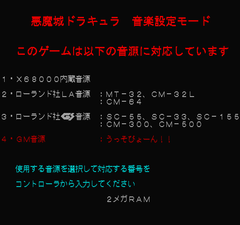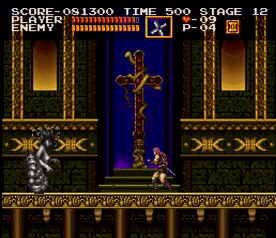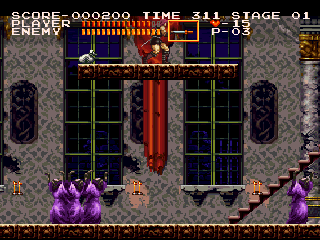Castlevania Chronicles
| Castlevania Chronicles |
|---|
|
Also known as: Castlevania Chronicle: Akumajou Dracula (JP)
|
Castlevania Chronicles is a port/remake of another port/remake of the original.
From here, the long history of Koji "IGA" Igarashi as the lead producer of series, gets started...
Contents
Music Test
Staff Credits Track
Using the GameShark code D0059270 0100 + 8011DD68 0010 and pressing Select on the music test screen allows the staff credits track to be played.
Music Test in Arranged Mode
| To do: Screenshot? |
Using the GameShark code D0059270 0800 + 80059286 0000 and holding Start when selecting arranged mode allows access to the music test. The music test seems to have been in early development as the screen is slightly squashed, yet fully functional.
Demo Leftovers
These were left over from a probably demo version of the game, present in all known original PlayStation versions.
Castlevania Chronicles
Castlevania
![]()
The Castle Dracula of ancient times will now be resurrected!!
Akumajou Dracula X68000 Leftovers
| Omake 1, #64 in DRACULA.PAC | Omake 2, #65 in DRACULA.PAC |
|---|---|
 |
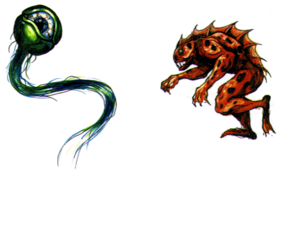 |
There are two unused pictures from the original X68000 version of this Akumajou Dracula game. They are concept art of enemies that were once used as "omake" files hidden in the X68000 version's game data as a small bonus. The PlayStation port may simply read the game data out in one big chunk and it may have been converted for Chronicles' use, but it's unknown why the copyright info of the original two pictures are gone. Perhaps the original pictures are rendered by actually drawing them to the screen, whereas Chronicles' version just stored the pictures as raw data.
| In-Game | Alternate | Doppelganger | |
|---|---|---|---|
| Original Mode | |||
| Arrange Mode |
Though the sprite which Simon is taking damage had been changed in Chronicles, the original sprite from Akumajo Dracula X68000 is still in the game's data, and even has its updated Arrange Mode counterpart. The Doppelganger's taking damage sprite uses Simon's original X68000 move set in both modes.
All three versions of old Konami jingle are in the music file (MUSIC.VB2) but upon selecting one sound module version in Original mode, the game jumps straight to the opening demo instead of displaying the old Konami logo first.
X68000 internal FM Synthesizer version
Roland CM-64 version
Roland SC-55 version
Regional Differences
Being a port/remake of a Japan-exclusive game, some things were changed for the international releases (Or fixed porting issues in the original Japanese release, in the Japanese PSN version's case).
KCET Logo
In the Japanese version, after the Konami logo fades out, this KCET logo appears. This graphic is still present in the game data of international releases, but it doesn't appear.
Title Screen
| Japan | International |
|---|---|
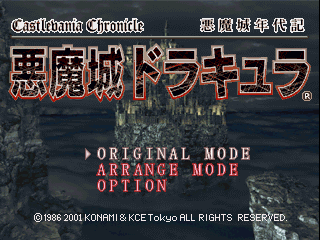 |
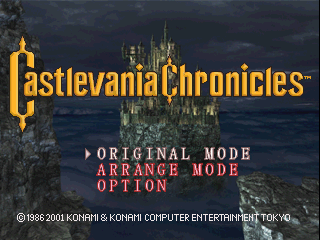 |
In the international releases, KCE Tokyo is shown as Konami Computer Entertainment Tokyo, and the background is compressed horizontally compared to the Japanese release.
Sound Module Selection
| Japan | Early International | International |
|---|---|---|

|
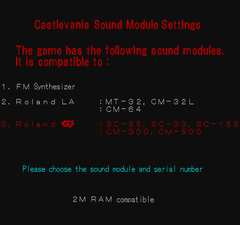
|

|
In the Japanese release, starting the Original Mode brings up a mockup of the original Sharp X68000 loading screen. In the international releases, it is enabled by pressing R1 and L1 while entering Original or Arrange Mode. However, there are early versions of Castlevania Chronicles that do not need the R1 + L1 combo to access this screen, similar to the Japanese release.
There is a hidden message about the unfinished GM sound module while you are on the sound module select screen and hold L1 + O + X on the second controller. The sampling and emulation of GM sound module was not finished in time when the port was going to be out, so instead of enabling it, the game tells you "うっそびょーん!!" ("Just kidding!!").
The hidden message has been dummied out overseas, but the graphic for such text survived (though unused in-game) in the game's data. It is also present in the much later Japanese PSN revision with a PS3 controller plugged in PS3/PSVTV/PSTV 's second controller slot.
Stage Layout Difference
| Japan | International |
|---|---|
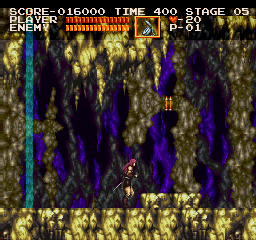 |
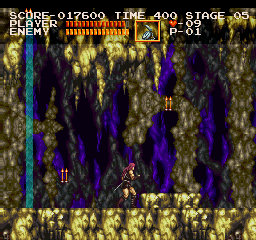 |
In the Block 2-2, a single candle which holds a small heart can be seen in the international releases. It is normally unseen in the Japanese release, but will appear if players are doing backtracking.
| Japan | International |
|---|---|
 |
 |
The screen size of the international releases have been slightly altered, and the current unloaded areas on the top of the screen will sometimes show a strange purplish line.
The altered screen size would move the Medusa spawn point at Block 4-1 and 5-1 a little higher.
| Japan | International |
|---|---|
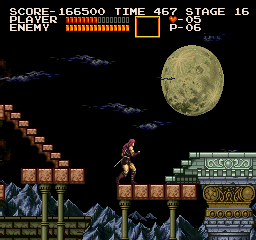 |
 |
The international releases used a modified background for the falling bridge section of Block 6-1.
| Japan | International |
|---|---|
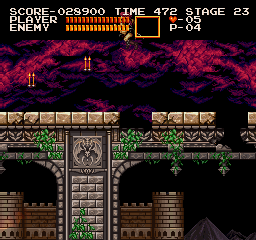 |
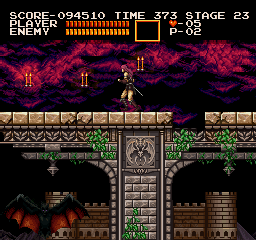 |
In the Block 8-2, the bridge of Castlevania Keep, there are some giant bats flying around. The international releases have one more bat compared to the Japanese release, which seems to actually have that bat coded. However, upon approaching the area where the bat should be, it just disappears for unknown reasons (possibly because of something overlooked during the porting process. In the original X68000 game, the bat properly appears in this position).
| Japan | International |
|---|---|
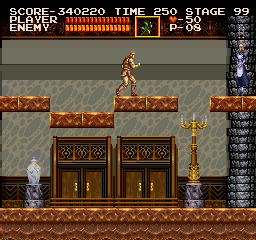 |
 |
In the Block 8-3, at the exit of the first screen a maid will always spawn in front of a column in the Japanese release. This specific maid will not spawn in the following international releases.
Sub-Weapon Difference
| Japan | Early International | US/Europe |
|---|---|---|
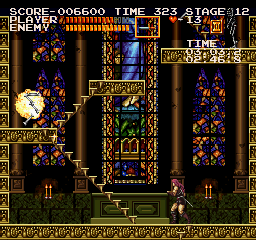
|
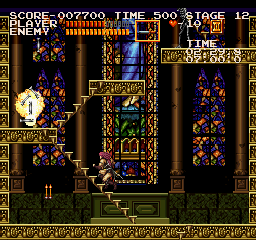
|
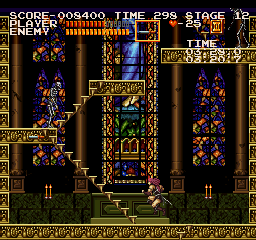
|
The knife and cross boomerang in the Japanese release can reach enemies that are at a higher level if the player jumps. It's still possible in the early international builds, but was later modified in the US and Europe releases.
| Japan | International |
|---|---|
 |
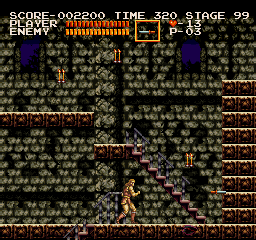 |
The sub-weapons can break fake walls and ice walls in the Japanese release, and this was also modified overseas (Also possibly due to porting issues).
Extras
| Japan | International |
|---|---|
 |
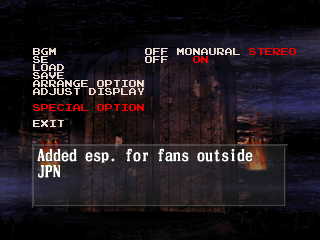 |
To make up for the fact that the original wasn't released overseas, the international releases included an interview with Koji "IGA" Igarashi and a gallery featuring artwork by Ayami Kojima from Castlevania Chronicles and the Saturn version of Castlevania: Symphony of the Night, complete with censored succubus. The text "DISPLAY ADJUST" is changed to "ADJUST DISPLAY" in the international releases.
Display Adjust
| Japan | US | Europe |
|---|---|---|
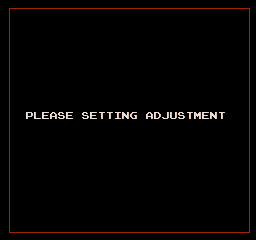
|
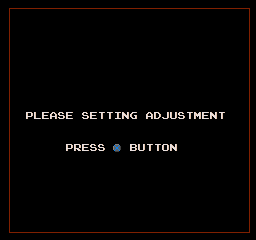
|

|
In the Japanese release, the text on the display adjust screen is simply "PLEASE SETTING ADJUSTMENT". In the US release, the text "PRESS X BUTTON" was added. The European release changed the upper text to "DISPLAY ADJUST" and brightened the orange border.
Konami Code
The code to set the game's internal time and display mode was changed between the Japanese and international releases, as the two main buttons (Circle and X) had their functions reversed.
| Japan | International |
|---|---|
| Up, Up, Down, Down, Left, Right, Left, Right, X, Circle, Start | Up, Up, Down, Down, Left, Right, Left, Right, Circle, X, Start |
Memory Card Text
| US | Europe |
|---|---|
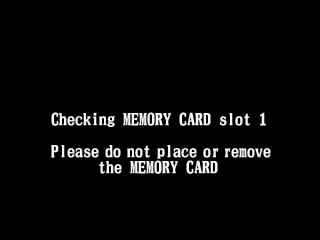 |
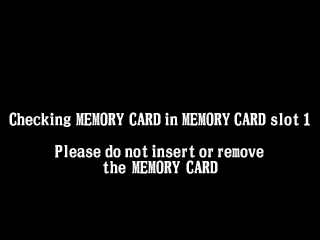 |
The saving/loading screens are a little more verbose in the European version, and correct "place" to "insert".
Others
A list of other differences from one version to others.
| To do: Document pictures/GIFs at corresponding difference text. |
| Japanese original | US/Europe | Japanese PSN | |
|---|---|---|---|
| Voice of French Dolls in the Tower of Dolls | Yes | No | Yes |
| Extended Medusa boss invulnerable time | No | Yes | Yes |
| Player can save progress in stage 24 | No | Yes | Yes |
| Mirrors, Blood Skeletons, Eyeballs and White Dragon award points | No | Yes | Yes |
| Block 4 Track "Bloody Tears" in higher pitch | No | Yes | Yes |
| "Bloody Tears" Red Skeleton pattern | Late | Early | Late |
| Overall Loading time | Shorter | Longer | Longer |
| Noise of Block 4-3 and 8-2's Spike Traps | No | Yes | No |
| Additional backtrack needed to completely destroy certain skeleton enemies in Block 3-3 | Yes | No | Yes |
Detailed Explanation
- The dolls in Block 6-2 (The Tower of Dolls) will speak Japanese when they are active and destroyed. All but one of these voice clips were dummied out in the international releases (「いや!」, or "No!", when defeated).
| Clip | Japanese | Translation | |
|---|---|---|---|
| SFX #236 | 「お前は誰!」 | "Who are you!" | |
| SFX #237 | 「帰りなさい。」 | "Begone." | |
| SFX #238 | 「やめて!」 | "Stop it!" |
- The Medusa boss in Block 4, the Chapel, remains invulnerable slightly longer after taking two hits in the international releases, making the boss a bit tougher in Original mode. This is because the original X68000 game was designed to render Medusa invulnerable for the same amount of time, but due to a porting issue you can actually jam 3 Cross Boomerangs and whip strikes to kill the boss instantly. She has no invulnerable time even though she gets knocked back and is flashing in the Japanese version. The international releases eliminated this problem and fixed her AI, so the cross combo can't finish her instantly.
- In the international releases, the player can save the game at stage 24, just before the battle with Dracula.
- Players are always given 500 seconds of stage time in the original Japanese releases when they lose a life in any sections of final stage, including the Dracula battle. International versions and later Japanese PSN releases reduces the stage timer to 400 seconds when players die in Block 8-2 and further reduced it to 300 seconds should they die in Block 8-3 onwards.
- For the same reason mentioned above, the mirrors in Block 6-3, as well as the blood skeletons, eyeballs, and bone dragons in various stages do not award points in the Japanese release. The mirrors and the eyeballs will award points if two or more of them are eliminated at once using the cross boomerang, the same as other minor enemies. However the blood skeletons do not award any points, due to the fact that the Japanese release treats them as if they were moving traps.
| Japan | International |
|---|---|
 |
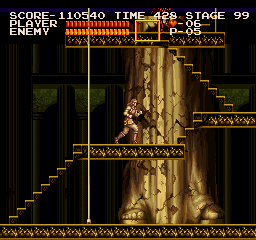 |
- The Block-4 music track, "Bloody Tears" in Arrange mode is slightly different in the international and later Japanese PSN releases. The pattern of blood drops in Block 4-2 (the "Bloody Tears" section) is also different between the Japanese and international releases with the latter almost forcing players to either trade hits with blood skeletons or keep the stopwatch sub-weapon from Block 3-3 all the way to the end of Block 4 - to the point of immediately riding on the brutally high difficulty rail in the hidden NOMIS mode (the one-hit-perish mode).
- The loading time of entering both the main menu and a stage is slightly longer in the international and Japanese PSN releases.
- Spike traps in Block 4-3 and 7-2 have noise in the international releases, but still not included in the Japanese PSN re-release.
- The noise is lifted from the original X68000 version, and indexed as sound effect #136 in DRACULA.PAC.
- A skeleton can be encountered at the last stair section of Block 3-3. In the Japanese version the skeleton will respawn immediately after climbing the stair thus players need to do two more backtracks in order to completely destroy the skeleton. May or may not be a port oversight, this unusual respawn feature has been removed in any existing version of western releases - though this minor point only affects speedrun strategies and is not normally noticeable by regular players, pretty much like almost every other differences mentioned above.
Oddities
In Block 1-1, a money bag worth 1000 points is hidden away and it can't be obtained in the final game without the help of moon jump GameShark codes D0059270 0042 + 8005A834 000B. Activate the GameShark code, press R2 + X and float to the topmost platform and move to the center in order to reveal the normally-unseen money bag.
References
- Games developed by Access
- Games published by Konami
- PlayStation games
- Games released in 2001
- Games released in May
- Games released on May 24
- Games released in October
- Games released on October 8
- Games released in November
- Games released on November 9
- Games with unused graphics
- Games with unused music
- Games with regional differences
- Games with revisional differences
- Games with hidden bonus content
- Pages with a Data Crystal link
- To do
- Castlevania series
Cleanup > To do
Games > Games by content > Games with hidden bonus content
Games > Games by content > Games with regional differences
Games > Games by content > Games with revisional differences
Games > Games by content > Games with unused graphics
Games > Games by content > Games with unused music
Games > Games by content > Pages with a Data Crystal link
Games > Games by developer > Games developed by Access
Games > Games by platform > PlayStation games
Games > Games by publisher > Games published by Konami
Games > Games by release date > Games released in 2001
Games > Games by release date > Games released in May
Games > Games by release date > Games released in May > Games released on May 24
Games > Games by release date > Games released in November
Games > Games by release date > Games released in November > Games released on November 9
Games > Games by release date > Games released in October
Games > Games by release date > Games released in October > Games released on October 8
Games > Games by series > Castlevania series


